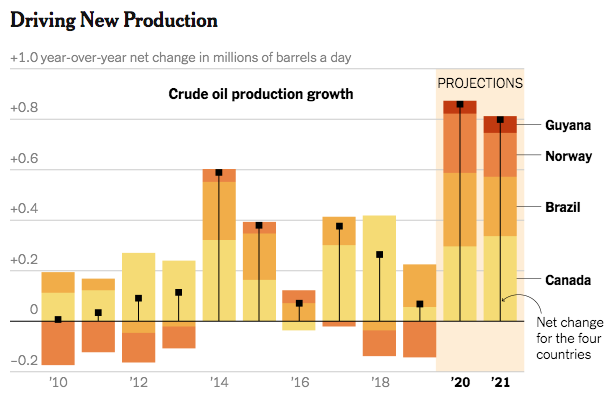Four countries are estimated to increase their combined oil production by almost one million barrels per day each in 2020 and 2021. That increase is expected to lower oil prices despite the expectation that OPEC and Russia’s oil production would be cut further as a result. The four countries (Norway, Canada, Brazil, and Guyana) are relatively stable, unlike Venezuela and Libya, and should provide a cushion in case of renewed attacks on oil tankers or processing facilities in the Persian Gulf. This expected oil production increase along with the increased oil production expected in the U.S. Permian Basin due to new pipeline capacity should make the world awash in affordable oil for the near future.

Norway
Norway’s rebound from 19 years of decline in oil production began recently as Equinor (previously Statoil) began production in its Johan Sverdrup deepwater field. The field should eventually produce 440,000 barrels a day, increasing the country’s output from 1.3 million barrels a day to 1.6 million barrels a day next year and 1.8 million barrels per day in 2021.
Brazil
In Brazil, new offshore production platforms are coming online. Oil production increased over the last year by 300,000 barrels a day, and the country is expected to add as much as 460,000 more barrels a day by the end of 2021. Shortly, Brazil is scheduled to hold a major auction in which oil companies will bid for drilling rights in offshore areas with as much as 15 billion barrels of reserves.
Canada
In Canada, resistance to new pipelines and high costs for oil sands production curtailed investments for five consecutive years. The 1,000-mile Line 3 pipeline that will move oil from the Alberta fields to Wisconsin, however, is nearing completion and awaiting final permitting. This new outlet could increase Canadian production by about a half million barrels a day, or around 10 percent.
Guyana
Guyana, a small South American country, currently produces no oil, but is expected to, despite Venezuela’s claims to a large portion of its territory. Guyana’s fields are located offshore, where drilling by a Chinese state company, which has an oil investment in Guyana, along with Exxon Mobil and Hess should be largely protected. Exxon Mobil has made several major oil discoveries in Guyana over the last four years. Oil production is expected to reach 120,000 barrels a day early next year, increasing to at least 750,000 barrels per day by 2025, and more after that.
Texas
New pipelines in Texas are expected to increase U. S. oil exports to 3.3 million barrels a day in 2020, above the current 2.8 million barrels per day. Hydraulic fracturing and horizontal drilling in tight shale fields made the United States into a major oil exporter. The increase in American production, along with an inconsistent global economy, cut oil prices from over $100 a barrel before the 2008 global recession to about $56 recently for American benchmark crude.
Shale Revolution Saves U.S. Consumers Billions
The U.S. Council of Economic Advisers reported that lower oil and natural gas prices due to the shale revolution save U.S. consumers $203 billion annually, or $2,500 for a family of four. Natural gas prices declined 63 percent from 2007 to 2018, representing $2,000 of the $2,500 in household savings. Lower oil prices impacted the cost of gasoline and heating fuels, helping to save consumers an additional $500. The decline in natural gas prices also provided indirect savings for consumers as electricity prices declined 45 percent over this time period. Low-income households benefit the most because they spend a larger portion of their income on electric and heating bills. Nearly half of American households rely on natural gas to heat their homes, with an annual cost of $634.
From 2007 to 2019, innovation in shale production brought an eight-fold increase in extraction productivity for natural gas and a nineteen-fold increase for oil. These productivity gains reduced costs and spurred production. As a result, the United States is the world’s largest producer of both fuels, surpassing Russia in 2011 for natural gas and Saudi Arabia and Russia in 2018 for oil. The increase in productivity reduced the domestic price of natural gas by 63 percent as of 2018 and led to a 45 percent decrease in the wholesale price of electricity. Shale production also reduced the global price of oil by 10 percent as of 2019.
Conclusion
The world can expect lower oil prices as oil production is expected to increase in the United States, Canada, Brazil, Norway, and Guyana over the next two years as new fields are developed and pipelines are built to move the oil. The shale revolution spurred by hydraulic fracturing and directional drilling resulted in the United States becoming the largest natural gas and oil producer in the world. These events are adding to global energy security and affordability while helping American families.